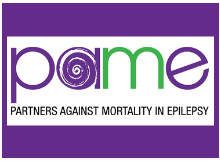 The American Epilepsy Society notes that one in 26 Americans will develop epilepsy over the course of their lifetime, and that in the run up to the June 23-26 Partners Against Mortality in Epilepsy (PAME) Conference, epilepsy experts and people who experience seizures are working to raise awareness of what is a greatly underestimated health problem category — epilepsy-related death. The AES observes that even though epilepsy affects three million Americans, communication and understanding with regard to epilepsy mortality risk remains low, creating a blind spot for caregivers that can prove disastrous.
The American Epilepsy Society notes that one in 26 Americans will develop epilepsy over the course of their lifetime, and that in the run up to the June 23-26 Partners Against Mortality in Epilepsy (PAME) Conference, epilepsy experts and people who experience seizures are working to raise awareness of what is a greatly underestimated health problem category — epilepsy-related death. The AES observes that even though epilepsy affects three million Americans, communication and understanding with regard to epilepsy mortality risk remains low, creating a blind spot for caregivers that can prove disastrous.
The multi-day PAME Conference learning event will be held at The Westin Alexandria in Alexandria, Virginia, and is the only meeting focused exclusively on increasing understanding of mortality in epilepsy, including Sudden Unexpected Death In Epilepsy (SUDEP). The Centers For Disease Control and Prevention (CDC) says studies suggest that each year there are about 1.16 cases of SUDEP for every 1,000 people with epilepsy, although estimates vary. Most, but not all, cases of SUDEP occur during or immediately after a seizure.
 The biennial PAME Conference is unique in that it brings together a diverse group of stakeholders, including patients and their families who are invited to share their stories; clinical and basic science professionals, healthcare providers who may earn continuing medical education (CME) credits for their participation under the auspices of AES; research scientists investigating mortality in epilepsy; early career fellows who are developing their research specialties and portfolios; research funders; and nonprofit organizations that provide patient support and lead advocacy efforts, in order to to advance research, facilitate collaborations, engage patients to participate in critical clinical research, and to increase urgency with respect to addressing an overlooked and underfunded public health issue. Public policymakers and selected media representatives are also invited to participate.
The biennial PAME Conference is unique in that it brings together a diverse group of stakeholders, including patients and their families who are invited to share their stories; clinical and basic science professionals, healthcare providers who may earn continuing medical education (CME) credits for their participation under the auspices of AES; research scientists investigating mortality in epilepsy; early career fellows who are developing their research specialties and portfolios; research funders; and nonprofit organizations that provide patient support and lead advocacy efforts, in order to to advance research, facilitate collaborations, engage patients to participate in critical clinical research, and to increase urgency with respect to addressing an overlooked and underfunded public health issue. Public policymakers and selected media representatives are also invited to participate.
Organizations leading the PAME partnership include the American Epilepsy Society (AES), Citizens United for Research in Epilepsy (CURE), and the Epilepsy Foundation (EF). Other major contributing organizations include the Danny Did Foundation and the Patrick Ring Foundation.
The 2016 PAME meeting is the third biennial conference hosted by the AES and planned by the PAME partnership, and will offer more than 50 presentations on the latest research in epilepsy mortality through panels and educational sessions designed to close gaps in knowledge and understanding of SUDEP and related issues including:
• Factors that predispose people to die from epilepsy remain unclear, with researchers having proposed explanations ranging from irregular heart rhythm and genetic predisposition to accidental suffocation during sleep. A panel of leading genetic and epilepsy experts explores what is known and not known about biomarkers and other risk factors for death in epilepsy.
• Genetic analysis and discovery in SUDEP – While much of the research into genetic risks of SUDEP has focused on single gene mutations that cause both epilepsy and sudden death, emerging new research is linking these genes to SUDEP.
• Options for prevention – While there is much remaining to be discovered about underlying causal mechanisms of SUDEP mortality, prevention strategies are now available, with avenues to be explored including the latest in device research, upcoming practice guidelines, and patient education needs.
The AES notes that SUDEP is the most common cause of epilepsy-related death, taking more lives annually in the United States than fires and sudden infant death syndrome (SIDS) combined, advising that cases of SUDEP manifest without warning in otherwise healthy people living with epilepsy and for whom no other cause of death can be identified, and are now recognized as the leading cause of epilepsy-associated mortality, excluding status epilepticus and underlying etiologies. However, despite the problem’s importance and implications for intervention, SUDEP did not begin to receive widespread professional attention in the United States prior to the mid 2000s.
However, the general level of awareness and interest in SUDEP has grown over the past decade, evidenced by growing numbers of publications, posters/presentations and attendance at the SUDEP SIG at recent AES annual meetings. In addition, the AES observes that there has been a significant rise in the number of inquiries from clinical and basic scientists, as well as from patients and families via advocacy organizations requesting more information regarding cutting-edge research, participation in clinical studies, possible collaborations, and networking. It was this pent-up demand that led to the original concept of a meeting that would address multiple needs of the SUDEP community.
“No words can describe the horror and devastation of unexpectedly losing a child or loved one to epilepsy. SUDEP has been a silent killer for far too long,” says Gardiner Lapham, bereaved mother, PAME Co-Chair, and Citizens United for Research in Epilepsy (CURE) board member, in an AES release. “PAME, a unique and dynamic collaboration of families and professional, is calling on the medical community to confront and disclose all risks of epilepsy, including SUDEP, so that individuals and families are empowered with information to make safe and informed decisions.”
Besides SUDEP mortality, epilepsy-related deaths also occur from status epilepticus (prolonged seizures), suicide, and fatal accidents that occur during a seizure, such as drowning, burning, choking, or falling. However in such instances, epilepsy is often not listed as a cause of death on death certificates, which makes it difficult for public health officials to quantify incidence of epilepsy-related death and draw attention to the problem.
Consequent lack of accurate, systematic epilepsy mortality data hampers doctors and researchers in developing greater understanding of circumstances that potentially make individuals more vulnerable. The lack of data also presents clinicians with challenges in deciding what to disclose to patients and families about their level of risk and in advising them on what are the best SUDEP prevention strategies. A panel at PAME 2016 will explore ways to improve epidemiology and surveillance, increase data collection and explore populations that aren’t typically counted.
To learn more about the PAME conference or to register, visit:
http://pame.aesnet.org
Discounted rates for early registration end on May 16.
Sources:
American Epilepsy Society
Partners Against Mortality in Epilepsy Conference (PAME)
Centers For Disease Control and Prevention (CDC)


